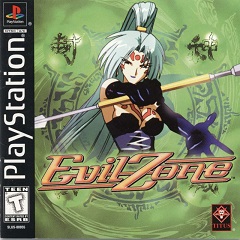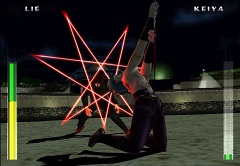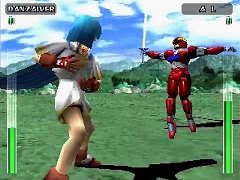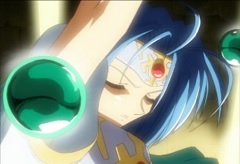
Evil Zone
By the late 1990s, 3D fighters were quickly gaining in popularity. During the first half of the decade, 2D dominated the genre with the likes of Street Fighter II, Mortal Kombat, and various entries from SNK battling for people’s attention. Regardless of graphical style, though, a discussion was beginning to emerge that still comes up to this day. It was the question of whether or not control schemes in fighting games were overly complicated, consequently becoming a turn off to potential newcomers to the genre. For some, inputting quarter circles, charge back forward, or some other combination of buttons was not at all intuitive, and they would either button mash until they got bored of the game, or they might not even give it a try to begin with.This is where Japanese developer Yuke’s came in with their 1999 PlayStation 3D fighting game Evil Zone. What they came up with was a heavily streamlined control scheme were players only needed to use the directional pad, a guard button, and an attack button. From there, attacks were performed via the simplest of inputs. These would vary depending on the distance between combatants as well as whether the player was pressing up, down, left, or right on the direction pad while hitting the attack button. At first, this would likely feel a bit strange to people just picking up the game, as it required a fair amount of trial and error to learn how and when different attacks were executed. Moreover, these attacks would vary from character to character, requiring a bit of practice with each one. After a time, one could figure out what the various characters move sets were as well as identifying inputs that are fairly universal between them, such as how to launch projectiles or perform a throw.
Evil Zone even managed to throw an interesting new idea into the mix with how it implemented super attacks. As is often the case with these sort of heavy-hitting attacks, players would need to build up a meter before unleashing them. What made this unique here was that the meter was connected to a character’s health bar. So, if they had a lot of health, it took a long time to fill their super meter, meaning these attacks couldn’t be used often in such a case. Conversely, if the player’s health bar was running low, they could fill it up quickly, granting more frequent access to their supers. As such, it opened the door for some clutch comebacks, making the latter half of a fight particularly intense.
Generally, Yuke’s managed to accomplish what they set out to do in terms of making a fighting game more approachable to new people by simplifying its controls. After an hour or so of play, most people would have a good idea of what they were doing for at least a couple of characters. There weren’t a lot of developers trying to do this at the time, and for some it was a welcome change of pace.
This did split the audience, though. Those who didn’t play a lot of fighting games got a kick out of the simplified controls, as it made Evil Zone more approachable to them. They didn’t have to spend a bunch of time reading move lists, then practicing these attacks for hours on end. They could simply hop right in and get down to business. The flip side of this was that veterans of the genre felt that having attacks whittled down to one button stripped the game of most of its depth. As such, there was a marked split in opinions regarding the game. This asks the question, though, as to who Evil Zone was created for. With its heavily streamlined control scheme, it makes much more sense that the game was developed with novices in mind as a doorway to fighting games. It wasn’t created specifically for people who lived and breathed Street Fighter, Tekken, KoF, and such. As the years passed, this idea of simplified controls would continue to evolve, but it would be the Smash series that lead the charge here. As a quick aside, it’s interesting to note that the first game in that series also released in 1999. So it was the dawn of a very different approach to fighting games that year, and while Yuke’s fighter here is largely forgotten, Nintendo’s fighting game series is doing better than ever these days.
As one can see, the game also had a very anime look to it. In fact, the story mode was set up to feel like an anime series was unfolding for each character, with each new fight having a preamble similar to the preview of a new anime episode. It was a clever move that made Evil Zone’s story feel a lot fresher than other fighting games of the time which tended to have a more stripped down experience. There was an over-arching plot about an evil entity named Ihaldulca that has been imprisoned in a realm known as Evil Zone. Now a tournament is being held to find the strongest fighter who can destroy her once and for all. Each character has their own back story for why they’re at the tournament with things getting fleshed out in the anime-like fashion previously described. There are plenty of tropes to be founds in the game’s plot, but its still a fun ride.
Of course, the visual style is pure anime, and this comes through reasonably well in the polygonal models of the characters. It looked decent for the time and had a few little details that caught players attention such as how characters’ clothing moved at times. However, the graphics weren’t exactly the cream of the crop for what was happening visually on the PlayStation. Environments in particular could actually be quite bland, especially when compared to other 3D fighters on the system at the time.
That being said, character design was typical of popular anime series to come about in the late 90s with stuff like a priestess, a brash female fighter, a body armor-wearing super soldier, a cool, handsome man in a suit, et cetera. What makes the art particularly interesting is that it was handled by the anime studio AIC. Unfortunately, nowadays, most discussion of the company starts with, “Whatever happened to AIC...” but there was a time when they were pumping out some of the best anime of the 80s and 90s including shows like Bubblegum Crisis, Tenchi Muyo, and Ah! My Goddess!, so these guys were no slouches. Evil Zone was one of the few times that AIC leant their expertise to a video game, making this something of particular note for fans of retro anime. This also resulted in some fairly well-established voice actors being involved with the Japanese version of the game, including the voices of Lancer from the Fate series, and Kagura from Azumanga Daioh.
Musically, Evil Zone had a lot of rock numbers in it with some other pieces that were a mix of tunes one might expect to hear in the background of a 90s anime. They’re all up tempo and help keep the fights exciting. Since the game is trying to feel like an anime, most of the tracks try to heighten this, emulating the sort of soundtrack one might expect from these shows. Interestingly, the same company that handled the soundtrack for Lords of Thunder on the PC Engine CD were tapped to do the music for Evil Zone, and their expertise shines through.
Before concluding, it’s worth noting that there are some inconsistencies between the Japanese and Western versions of the game. For one, the Japanese voice acting is only in the Japanese version of the game. This is exacerbated further by characters mouths being out of sync with the English voice actors because they’re still animated to line up with the Japanese dialogue. Also a number of music numbers were removed for the Western release and replaced with instrumentals, presumably due to the Japanese record labels of the pop singers who performed the songs putting regional restrictions on the music. Finally, the animated opening still refers to the Japanese name of the game in Western versions, causing some confusion.
As the 90s were drawing to a close, there were quite a few 3D fighting games coming out. It was an exciting new style of game with a lot of possibilities during the time. Twenty years on, the likes of Tekken, Virtua Fighter, and even games like Bloody Roar still get mentioned from time to time when people reminisce about 3D fighters of that era. Unfortunately, Evil Zone is one that doesn’t get anywhere near as much discussion, which is a shame. It tried to do something different with its simplicity and generally succeeded. Meanwhile, its anime veneer was an additional nice touch. However, this didn’t prevent the game from largely being forgotten. Those looking for a fighting game on the PlayStation that’s a little bit different might do well to consider this one.
- IroIro
December 12, 2019
Other Fighting Games that We've Discussed:
- Star Gladiator Review (PlayStation)- Gundam Wing: Endless Duel Review (Super Famicom)
- Battle Arena Toshinden Review (Gameboy)
Genre: Fighting
Developer: Yuke's Future Media Creators
Publisher: Yukes' / Titus Interactive
Released: 1999

PlayStation US Box Art

Lie doing a super attack

Al preparing to pummel Danzaiver

One of the anime sequences that AIC created